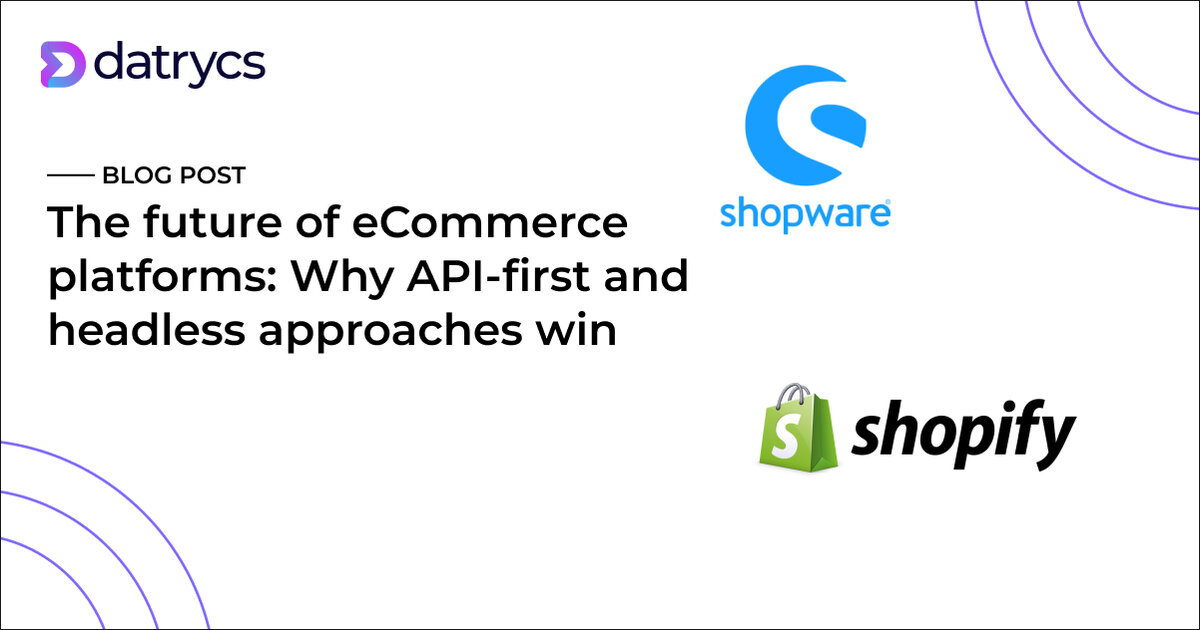Embracing the Future: Moving to Composable Commerce
The idea of "composable commerce" has arisen as a game-changer as firms continue to struggle with shifting customer demands and technology breakthroughs.



The evolution of the ecommerce ecosystem
E-commerce has come a long way since its inception. From static web pages and basic online shopping carts, it has transformed into a dynamic and personalized experience. However, this transformation hasn’t always been smooth. Traditional monolithic commerce platforms often struggled to keep up with the demands of a rapidly changing market. The evolution of the e-commerce tech stack has been pivotal in enabling these dynamic and personalized experiences.
What is Composable Commerce?
Composable commerce is a new approach to building and managing e-commerce systems. It involves breaking down the various components of an e-commerce platform into smaller pieces that can be easily assembled and customized to meet specific business needs. Instead of relying on a one-size-fits-all solution, businesses can now pick and choose the building blocks that work best for them. By integrating AI solutions, businesses can further enhance their composable commerce systems to analyze data, manage risks, and improve consumer interactions.
Key elements of Composable Commerce:
- Microservices: Composable commerce relies on microservices architecture, where each component of the e-commerce platform is developed and maintained independently. This allows for greater flexibility and scalability.
- API-First: An API-first approach ensures that different components can seamlessly communicate with each other. This means you can integrate third-party services and adapt to new technologies with ease. This approach also allows businesses to leverage AI to enhance inventory management and other critical operations.
- Modularity: Composable commerce platforms are built with modularity in mind. This enables businesses to add, remove, or replace components as needed, reducing vendor lock-in.
Benefits of Composable Commerce technology
Composable commerce technology offers numerous benefits to businesses, transforming how they operate and engage with customers. One of the most significant advantages is flexibility and scalability. Unlike traditional monolithic systems, composable commerce allows businesses to easily integrate new technologies and scale their operations without being constrained by legacy systems. This adaptability is crucial in a rapidly evolving digital commerce landscape.
Another key benefit is the improved customer experience. By leveraging AI applications and composable commerce technology, businesses can create personalized and seamless shopping experiences that meet evolving consumer expectations. For instance, AI-driven product recommendations and personalized marketing campaigns can significantly enhance customer satisfaction and loyalty.
Increased efficiency is another advantage. Composable commerce technology enables businesses to automate manual tasks and streamline operations, reducing the need for minimal effort and increasing productivity. This efficiency not only saves time but also allows businesses to focus on strategic initiatives that drive growth.
Moreover, enhanced product descriptions generated by AI can improve customer engagement and conversion rates. Generative AI can create high-quality, detailed product descriptions that resonate with customers, making it easier for them to make informed purchasing decisions.
Finally, adopting composable commerce technology and AI applications provides a competitive advantage. Businesses that embrace these technologies can differentiate themselves from competitors and establish themselves as industry leaders. By staying ahead of the curve, they can better meet customer needs and drive long-term success.
AI applications in Composable Commerce
AI applications are revolutionizing composable commerce by enhancing both customer experience and operational efficiency. One of the most impactful uses of AI is in content generation. Generative AI can create high-quality content, such as product descriptions and blog posts, that not only improve customer engagement but also boost conversion rates. This automated content generation ensures consistency and saves valuable time for businesses.
Product recommendations powered by AI are another game-changer. These intelligent systems analyze customer behavior and preferences to suggest relevant products, enhancing the overall shopping experience. By offering personalized recommendations, businesses can increase sales and customer satisfaction.
Chatbots are also becoming an integral part of composable commerce. AI-powered chatbots provide customers with personalized support, answering queries and resolving issues in real-time. This not only improves customer satisfaction but also frees up human resources for more complex tasks.
In the realm of inventory management, AI can optimize stock levels, reducing the risk of stockouts and overstocking. By predicting demand patterns, AI helps businesses maintain optimal inventory levels, ensuring that products are available when customers need them.
Lastly, predictive analytics powered by AI can help businesses forecast demand and make data-driven decisions. By analyzing historical data and identifying trends, AI can provide valuable insights that inform marketing strategies, inventory management, and overall business planning.
Why Composable Commerce matters
- Flexibility and Customisation: Composable commerce allows businesses to tailor their e-commerce solutions to their unique needs. Whether it’s a new payment gateway, a loyalty program, or a recommendation engine, you can easily integrate the latest tools and technologies.
- Scalability: As your business grows, so do your requirements. Composable commerce makes it easy to scale specific aspects of your e-commerce platform without overhauling the entire system. This agility is crucial in a competitive market.
- Faster Time-to-Market: With pre-built components and APIs readily available, development time is significantly reduced. This means you can bring new features and products to market faster, staying ahead of the competition.
- Improved Customer Experience: Composable commerce enables businesses to deliver a more personalised and seamless shopping experience. With the ability to integrate AI-driven recommendations, chatbots, and other advanced features, you can engage customers in meaningful ways. AI solutions can further enhance customer experience by providing personalized recommendations and real-time support.
- Cost Efficiency: By only paying for the components and services you use, you can optimise your operational costs. This cost-efficiency is particularly valuable for small and medium-sized businesses.
Bringing Composable Commerce and AI together
Integrating composable commerce and AI requires a strategic approach to create a cohesive and efficient ecommerce ecosystem. The first step is integration. Composable commerce technology and AI applications must be seamlessly integrated to ensure smooth communication and functionality. This involves selecting compatible technologies and establishing robust APIs for data exchange.
Data quality is another critical factor. High-quality data is essential for AI applications to function effectively. Composable commerce technology can help ensure data accuracy and completeness, providing a solid foundation for AI-driven insights and actions.
Scalability is also crucial. Both composable commerce technology and AI applications must be scalable to meet the evolving needs of businesses and customers. This means choosing solutions that can grow with your business and adapt to changing market conditions.
Security is paramount in protecting customer data and preventing cyber threats. Businesses must implement strong security measures to safeguard sensitive information and maintain customer trust.
Finally, the integration of composable commerce and AI must prioritize customer experience. The goal is to create a seamless and personalized shopping experience that meets customer expectations. By leveraging AI to enhance personalization and streamline operations, businesses can deliver exceptional customer experiences that drive loyalty and growth.
The Future of ecommerce
The future of e-commerce is set to be shaped by the increasing adoption of composable commerce and AI applications. As businesses seek to improve flexibility and scalability, composable commerce technology is expected to become more popular. This modular approach allows businesses to quickly adapt to market changes and integrate new technologies with ease.
The growing use of AI applications will also play a significant role in the evolution of e-commerce. AI will continue to enhance customer experience and streamline operations, with applications ranging from personalized product recommendations to advanced inventory management.
One of the most exciting trends is the rise of generative AI. This technology is expected to play a larger role in e-commerce, particularly in content generation and product recommendations. By automating these tasks, businesses can improve efficiency and deliver more personalized experiences to customers.
Improved customer experience will remain a key focus. The integration of composable commerce and AI will enable businesses to create more personalized and seamless shopping experiences, meeting the high expectations of modern consumers.
Additionally, there will be an increased focus on sustainability. E-commerce businesses are expected to prioritize sustainability and reduce their environmental impact. This includes adopting eco-friendly practices and technologies that support sustainable growth.
Implementing Composable Commerce
Making the shift to composable commerce requires careful planning and execution. Here are some key steps to consider:
- Assessment: Evaluate your current e-commerce infrastructure and identify areas that could benefit from modularity and flexibility.
- Vendor Selection: Choose technology partners and vendors that align with your composable commerce strategy. Look for those that offer strong API support and a wide range of modular components. Choosing the right tech stack is crucial for ensuring seamless integration and optimal performance of your composable commerce system.
- Integration: Implement a robust integration strategy to ensure seamless communication between different components of your e-commerce stack.
- Training and Adoption: Invest in training for your development and IT teams to ensure they can effectively work with composable commerce tools and technologies.
- Continuous Optimisation: Regularly assess your e-commerce stack’s performance and make adjustments as needed to keep up with changing market dynamics.
As a result, composable commerce is more than simply a trend; it represents a paradigm change that enables companies to flourish in the fast changing e-commerce environment. Companies may maintain their competitiveness, provide outstanding client experiences, and position themselves for long-term success by embracing modularity, flexibility, and innovation. The moment to embrace the modular nature of e-commerce is now.
Best practices for Composable Commerce
To maximize the benefits of composable commerce, businesses should follow these best practices:
Start Small: Begin with a small pilot project to test composable commerce technology and AI applications. This allows you to identify potential challenges and make necessary adjustments before scaling up.
Focus on Customer Experience: Prioritize customer experience by creating a seamless and personalized shopping journey. Use AI applications to enhance personalization and improve customer satisfaction.
Integrate with Existing Systems: Ensure that composable commerce technology and AI applications are integrated with your existing systems. This creates a cohesive ecommerce ecosystem that supports efficient operations and data flow.
Monitor and Optimize: Continuously monitor the performance of your composable commerce technology and AI applications. Use data-driven insights to optimize processes and improve customer experience.
Stay Up-to-Date with Industry Trends: Keep informed about the latest trends and developments in composable commerce and AI. Staying ahead of the competition requires continuous learning and adaptation to new technologies and market dynamics.
By following these best practices, businesses can effectively leverage composable commerce and AI to drive growth, enhance customer experience, and stay competitive in the ever-evolving e-commerce landscape.


